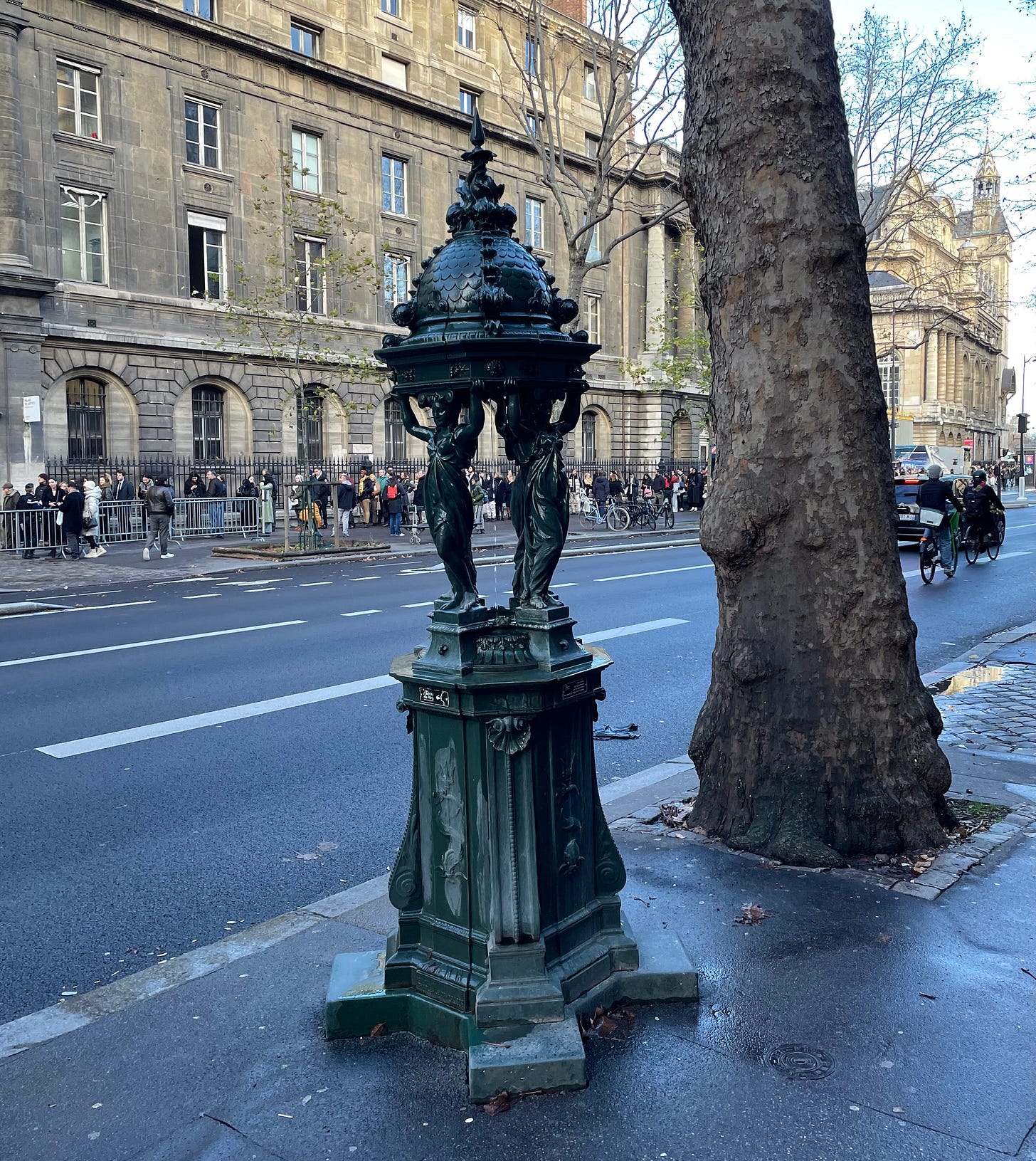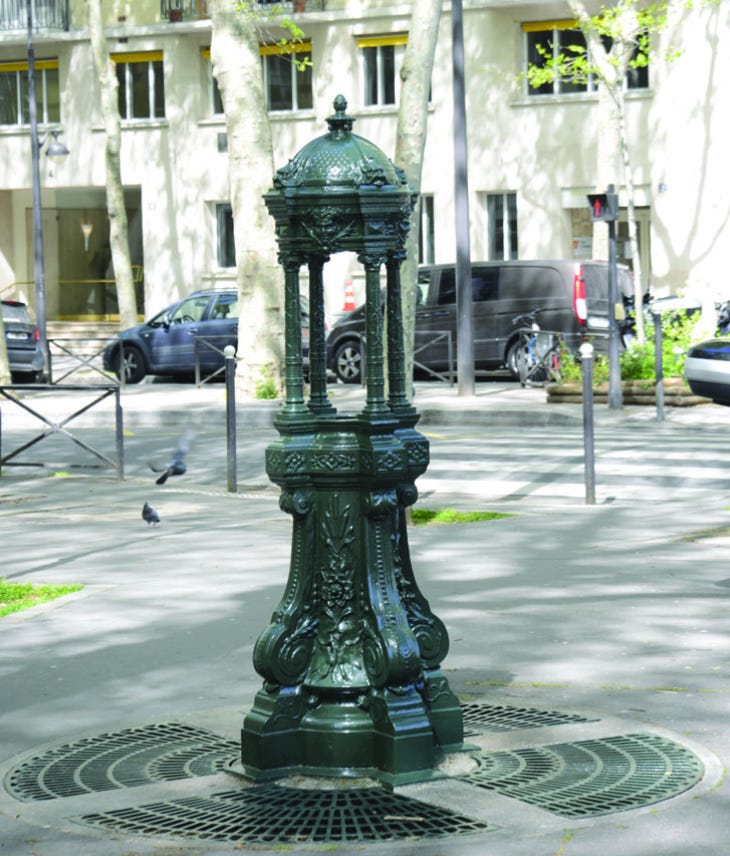If you have been to Paris, you have seen a Wallace fountain. They are iconic. Symbols of Paris. Spot one in a movie, and you immediately know where you are. Yet, you may not have actually noticed them because they fit so perfectly into the Paris cityscape.

The most common model is the “grand model.” It is 9 feet tall with four caryatids standing back-to-back supporting a fountain that produces a stream of water flowing into a basin. Most are painted the same shade of green as the city’s Second Empire street furniture (benches, gates, etc.).
They’re not just pretty. They actually work, providing clean delicious drinking water. They’re democratic, used by rich and poor alike. They reduce plastic use, although that wasn’t an original aim, since they were created long before plastic.
The originals date from 1872. And there are 109 remaining in Paris, located strategically to best supply the population with potable water from March 15 to November 15. (They are shut down during winter months to prevent pipes from freezing and breaking.)
If you ask a Parisian, they might know they are called “Wallace Fountains” or more familiarly “Les Wallaces,” but many won’t know who Wallace actually was. It’s a good enough story to tell you here, so buckle in for some Paris history you may not yet know!
It’s 1848. Napoleon’s nephew Napoleon III pulls a copycat of his uncle, is elected president, then 4 years later declares himself emperor. While Napoleon I wanted to take the world by force, his nephew wanted to take the world by seduction, and in 20 years pulled a total makeover of Paris along with his city planner Baron Haussmann and others. This included wide avenues, matching buildings, parks, railway stations, trees and benches everywhere, an updated sewer system, the buildings along the Champs-Elysées and the gorgeous department stores with indoor lighting (!) and elevators (!). Commerce was king and Paris was looking fabulous, dahling.
But in 1870 Napoleon III takes his eyes off the prize and is sucked into war against Prussia. He loses, the Prussians siege Paris for over 4 months and people are so hungry they eat the animals from the zoo and any other pet or rodent they can get their hands on. Destruction from artillery bombing destroyed aquaducts and other sources of clean water. Potable water was too expensive for most, and water sold by vendors was drawn from the Seine, which contained wastewater.

A few months later, the Communards take over, try to make things better, but in 3 months are massacred by the new government, who in 1 week killed around 15,000-20,000 people. (Blood was running into the river in streams.) By now, most people lived in complete squalor.
In the midst of this, a young Englishman named Richard Wallace was living in Paris and acting as secretary to the 4th Marquess of Hertford, a bachelor who was probably Richard’s father. The Marquess, who sounds like a complete ogre, taking pride in never helping anyone while spending his time amassing his art collection, died and left his enormous fortune to Richard.
Richard could have easily turned tail and scampered back to his birth-city of London, but having lived in Paris since he was six, he was dedicated to the city and its people. Almost as if to make up for his father’s miserliness, he immediately began using his vast fortune to help the suffering citizens of the city, funding ambulances, food, clothing, housing, fuel and healthcare.

In the end, he decided to return with the art collection to London in 1872. But before he left, he wanted to make one last gesture to help the people.
Waterborne diseases were common, with new cholera outbreaks occurring following a major epidemic in 1832. With no clean water, people turned to drinking only wine and beer to be safe. Public drunkenness became endemic among the poor. Children were given bread soaked in wine for hydration and became sick from it.
Richard considered it his moral duty to keep the poorer classes from falling into alcoholism. The Temperance Movement began in France in 1872 and Wallace was a major donor. “Temperance fountains” had already become a trend in England, and later the U.S., so the concept was in the zeitgeist.
Wallace decided to provide Paris with clean drinking water in the form of fountains. he sketched out a plan and then handed it to an artist friend, Charles-Auguste Lebourg to perfect. From the official Wallace fountain website:
His exacting guidelines referenced size, form, materials and cost. He specified the fountains must be “tall enough to be seen from a distance, but not so tall as to destroy the harmony of the surrounding landscape.” Their form must be “both practical to use and pleasing to the eye.” Their materials must be “resistant to the elements, easy to shape and simple to maintain.” Finally, cost was a major factor. Wallace wanted them to be “affordable enough to allow the installation of dozens.”
Before moving back to London and founding the Wallace Collection (one of the finest private art collections ever), Sir Richard Wallace gifted the people of Paris with even more money and 50 fountains, the first of which was installed in July 1872.
The first run included 2 models: 40 “grand” models and 10 “wall-mounted” models.
A 1875 edition of the Joanne guidebook described them such: “In one model, the water falls in a continuous jet from the centre of a dome supported by four caryatids, filling a small bowl where the cups held by a chain are immersed. In another model, the water falls from a woman’s head, placed at the centre of a small circular pediment, filling a small wall-mounted bowl between two pilasters.”

There were practicalities that went into the design which make total sense when you look at them. They are elevated so stray dogs wouldn’t drink from them. (Those who weren’t eaten during the siege.) The caryatids are placed close enough that horses couldn’t use them. (Ditto.) There were originally two tin cups attached with chains that were left submerged in the continuously flowing water to be sanitary. And of course the continuously flowing water kept it from being stagnant and thus disease-prone. (Paris’s Council of Health had the cups removed in 1952.)
The fountains were so practical and popular that Wallace added ten more in 1876 and another ten in 1879. More were added later, at the request of each neighborhood, and two further models were produced: a colonnaded fountain and a “petite.”
Of the 4 original models, only 2 colonnaded examples still exist as well as 1 wall model. (The rest you find are the “grand” with the caryatids, and I’ve seen the “petites” all over the place, especially inside parks.)
Today’s 109 Wallace fountains are run by the “Eau de Paris” (“Paris Water”) company, which reports to the Paris government. (Including the Wallace fountains, there are 1200 water points through the city where you can fill your water bottle with clean, delicious water.)
Since the beginning, the water for the fountains comes from the same drinking supply that is run directly into apartments, so it’s the same as tap water. The fountains are fully disinfected every 2 weeks, and are on a constant restoration cycle, which is a major endeavor since they are each made up of 80 parts and weigh 1300 pounds (600 kilos). Cracks and damage are restored, they are repainted, and then placed back where they came from.
The caryatids are all distinct from each other by posture and draperies. They represent four virtues : Simplicity, Kindness, Sobriety and Charity, as well as representing winter, spring, summer and autumn. The base is octagonal, and the dome is covered with “fish scales.”

You can tell if the fountain is one of Wallace’s originals by checking the markings on the top of the pedestal. The oldest ones bear the name of the sculptor “CH. LEBOURG SC” and have the year 1872. On the opposite side is the name of the foundry “VAL D’OSNE.” The later replicas were produced by GHM and bear a “GHM” marking on the very bottom of the base.
And for those Atypical Paris nerds, the Wallace Fountains organization actually provides a checklist of every fountain in Paris so you can do your own scavenger hunt. If you send them proof you’ve found all of them, you get a certificate calling you a Friend of the Fountains. So you can bet your sweet bippy I’m starting ASAP.
As for Sir Richard Wallace, when he died in 1890, he was buried in Père Lachaise cemetery after a celebrated funeral cortege and was touted by all as “the Benefactor of Paris” and “the Providence of the Poor.” And to those who know the story, the fountains will forever remain as reminders of one man’s generosity.








